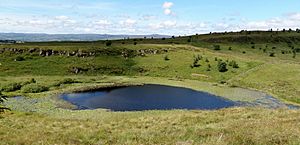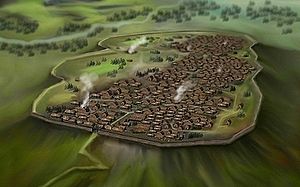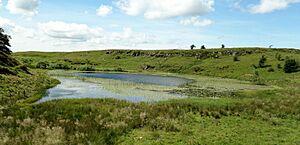Walls Loch facts for kids
Quick facts for kids Walls Loch |
|
|---|---|

Walls Loch as seen from the Walls Hill Iron Age Hillfort
|
|
| Lua error in Module:Location_map at line 420: attempt to index field 'wikibase' (a nil value). | |
| Location | Howwood, Renfrewshire, Scotland |
| Type | Freshwater loch |
| Primary inflows | Rainwater and surface drainage |
| Primary outflows | Muirhead Burn |
| Catchment area | Whittliemuir |
| Basin countries | Scotland |
| Max. length | 2,860 ft (870 m) |
| Max. width | 1,980 ft (600 m) |
| Islands | None |
| Settlements | Lochwinnoch |
Walls Loch is a beautiful freshwater loch (that's a Scottish word for lake!) in Renfrewshire, Scotland. It's located near the village of Howwood, right below a very old place called Walls Hill. This loch is about 560 feet (170 meters) above sea level.
Walls Loch is a natural lake, nestled in a dip in the land. Its waters flow out through a stream called the Muirhead Burn. The loch is quite big, stretching about 2,860 feet (872 meters) long and 1,980 feet (604 meters) wide.
Contents
A Look Back in Time: Walls Hill and the Loch
Walls Hill, right next to the loch, is home to an amazing Iron Age hillfort. This fort is the biggest of its kind in Renfrewshire. Experts believe it might have been an oppidum, which was a large, fortified settlement used by the Celtic Damnonii tribe. Some people even think the ancient name 'Vanduara' might be linked to Walls Hill.
Ancient Discoveries Near Walls Loch
In 1960, something very old was found on the shore of Walls Loch. It was a flint arrowhead, shaped with barbs and a tang. This type of arrowhead is typical of the Beaker People from the Bronze Age. These people were important because they helped bring metalworking to the British Isles.
Life Around the Loch Through the Ages
The Walls Hill fort was used at different times in history. One period of use likely ended when the Romans arrived in Britain. Later, it was used again between the 4th and 11th centuries. After that, Walls Farm was built in the 14th century, but it was later abandoned.
During all these times, Walls Loch was a very important resource. People and their animals would have used its water. Fish from the loch would have been a source of food. Rushes and reeds growing around the loch could be used for making things for their homes. Studies of ancient pollen from the Iron Age show that people living near the loch had a basic economy. They mostly relied on mixed farming, growing crops and raising animals.
Names That Tell a Story
If you look at old maps of the area, you'll see names like North Castlewalls and South Castlewalls. These names are a clue! They confirm that there was once a castle or fort on Walls Hill.
The Battle of Muirdykes
A historic event called the Battle of Muirdykes happened near Walls Loch. It took place on June 18, 1685, on Muirdykes Farm. This battle was fought between the Duke of Argyle's men and the forces of King James II. The King's army was defeated in this fight.



